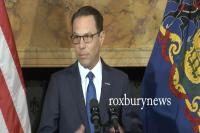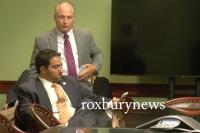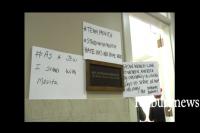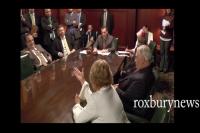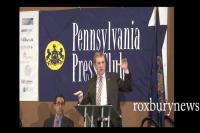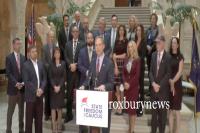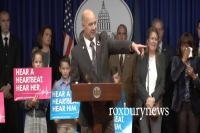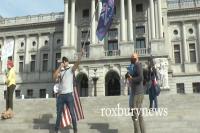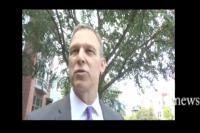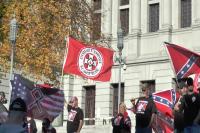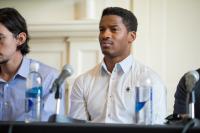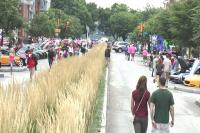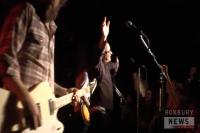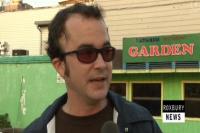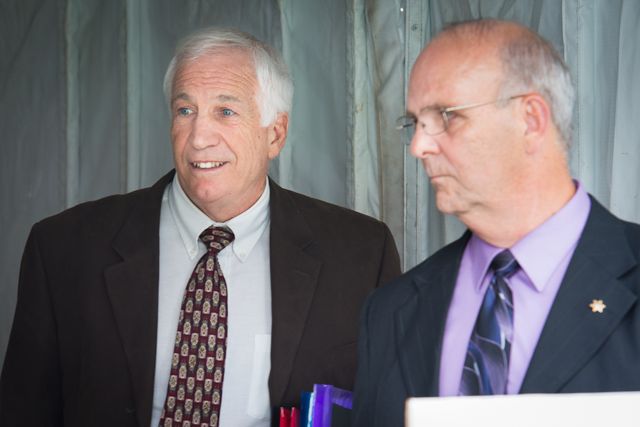rn rnREMARKS OF LOUIS FREEH IN CONJUNCTION WITH ANNOUNCEMENT OF rnPUBLICATION OF REPORT REGARDING THE PENNSYLVANIA STATE rnUNIVERSITY rnPhiladelphia, PA, July 12, 2012 ? Louis Freeh today issued prepared remarks in rnconjunction with today?s publication of his report of the investigation into the facts and rncircumstances of the actions of The Pennsylvania State University surrounding the child rnabuse committed by a former employee, Gerald A. Sandusky. Mr. Freeh will summarize rnthese remarks during his press conference at 10 a.m. today. rnMr. Freeh and his law firm, Freeh Sporkin & Sullivan, LLP, were retained in November rn2011 on behalf of the Special Investigations Task Force of the Board of Trustees of The rnPennsylvania State University to conduct the independent investigation. rnThe full text of the remarks follows: rnI. Introduction rn rnGood Morning. rnWe are here today because a terrible tragedy was allowed to occur over many rnyears at Penn State University, one in which many children were repeatedly victimized rnand gravely harmed. Our hearts and prayers are with the many children ? now young rnmen ? who were the victims of a now convicted serial pedophile. rnI want to remind everyone here, and those watching this press conference, of the rnneed to report child abuse to the authorities. In Pennsylvania you can report child abuse rnto the Department of Public Welfare?s ChildLine. That number ? which is on the screen rnbefore you ? is (800) 932-0313. It is our hope that this report and subsequent actions by rnPenn State will help to bring every victim some relief and support. rn Penn State University is an outstanding educational institution, which is rightly rnproud of its students, alumni, faculty and staff, who, in turn, hold the institution in very rnhigh esteem. We understand and respect their support and loyalty, and the spirit of rncommunity surrounding the University, which we witnessed first-hand during our seven rnand one half months of work on the Penn State campus. We also fully appreciate the rnstrong emotions which surround these tragic matters and our work. rnAll of us here today understand that it is the duty of adults to protect children and rnto immediately report any suspected child sexual abuse to law enforcement authorities. rnOur team was reminded of this on a daily basis because Henderson South, our base at rnPenn State, was the former Child Care Center at State College, with some of the rnchildren?s art work still in the space. 2 rn rnOn November 21, 2011, the Special Investigations Task Force established by the rnBoard of Trustees of The Pennsylvania State University retained my firm, Freeh Sporkin rn& Sullivan, to conduct a full, fair and completely independent investigation into the facts rnand circumstances raised by the Grand Jury report and the criminal charges against rnformer Assistant Coach Gerald Sandusky. rnI commend Ken Frazier, Chairman of the Task Force, and Ron Tomalis, Vice rnChairman of the Task Force, and their colleagues for the steps they took to ensure the rnindependence and thoroughness of our investigation. We would also like to rnacknowledge, in particular, the three Task Force members who are not members of the rnBoard of Trustees ? a faculty member, a student and a distinguished alumnus. rnTo conduct this independent investigation, we assembled an outstanding team of rnformer law enforcement, lawyers (one of whom is a former Navy SEAL) and officials, rnincluding former prosecutors, FBI Agents and Pennsylvania and Delaware State Police rnOfficers, with many decades of experience conducting sensitive investigations. I am rnpleased to be joined this morning by some members of our team. rnWorking exceptionally hard in a very short amount of time for an investigation of rnthis magnitude, my team conducted over 430 interviews of various individuals that rnincluded current and former University employees from various departments across the rnUniversity, as well as current and past Trustees, former coaches, athletes and others in rnthe community. We also analyzed over 3.5 million emails and other documents. The rnevidence found by our investigators included critical, contemporaneous correspondence rnfrom the times of these events. Our investigative team made independent discovery of rncritical 1998 and 2001 emails ? the most important evidence in this investigation. We rnalso confirmed, through our separate forensic review, that the correct year of the rnSandusky sexual assault witnessed by Michael McQueary was 2001, and not 2002 as rnset forth in the original Grand Jury presentment. rnIn performing this work, we adhered faithfully to our original mandate: to rninvestigate this matter fully, fairly, and completely, without fear or favor. We have rnshown no favoritism toward any of the parties, including the Board of Trustees itself, our rnclient. I can tell you that at all times we felt that our demand for total independence ? rnthe primary condition of our engagement ? was respected. rnWe took the unusual step of not providing any draft of the report to the Board of rnTrustees or to the Task Force prior to its posting this morning. They are seeing it at the rnsame time and in the same manner as everyone else, namely by accessing the rnindependent website we established for this purpose, rnwww.TheFreehReportonPSU.com. To be absolutely clear, this public release is the first rntime anyone outside of our investigative team has seen this report. rn In our investigation, we sought to clarify what occurred, including who knew what rnand when events happened, and to examine the University's policies, procedures, rncompliance and internal controls relating to identifying and reporting sexual abuse of rnchildren. Specifically, we worked to identify any failures or gaps in the University?s control environment, compliance programs and culture which may have enabled these rncrimes against children to occur on the Penn State campus, and go undetected and rnunreported for at least these past 14 years. As you will read in our report, Penn State rnfailed to implement the provisions of the Clery Act, a 1990 federal law that requires the rncollecting and reporting of the crimes such as Sandusky committed on campus in 2001. rnIndeed, on the day Sandusky was arrested, Penn State?s Clery Act implementation plan rnwas still in draft form. Mr. Spanier said that he and the Board never even had a rndiscussion about the Clery Act until November 2011. rnWhile independent, our work was done in parallel with several other active rninvestigations by agencies and governmental authorities, including the Pennsylvania rnAttorney General, Pennsylvania State Police, United States Attorney, Federal Bureau of rnInvestigation, and U.S. Department of Education. We continuously interfaced and rncooperated with those agencies and authorities. We also received assistance from the rnNational Center for Missing & Exploited Children (NCMEC). As promised, we rnimmediately turned over any relevant evidence we found to these authorities, such as rnthe critical February 27, 2001 emails between Messrs. Spanier, Schultz and Curley. rnThe complete emails are now available on our website. rnUnfortunately, portions of these emails have been leaked to the media. We rnstrongly condemn and deplore those leaks. Let me assure you that none of these leaks rncame from the Special Investigative Counsel team. As you will see by reading our rnreport this morning, not one conclusion, phrase, or any content of our report has been rnpublished or quoted prior to today. rnLast month Sandusky was found guilty after trial on 45 of 48 counts. He awaits rnsentencing. We were exceedingly careful not to do anything that would have impeded rnthat investigation and trial. Criminal proceedings are still pending against Mr. Schultz rnand Mr. Curley. We respect the criminal justice process and their rights to a fair trial. rnSome individuals declined to be interviewed. For example, on the advice of rncounsel, both Mr. Curley and Mr. Schultz declined to be interviewed. Also, the rnPennsylvania Attorney General requested that we not interview certain potential rnwitnesses. We honored those requests. Mr. Paterno passed away before we had the rnopportunity to speak with him, although we did speak with some of his representatives. rnWe believe that he was willing to speak with us and would have done so, but for his rnserious, deteriorating health. We were able to review and evaluate his grand jury rntestimony, his public statements, and notes and papers from his files that were provided rnto us by his attorney. rn 4 rn rnII. Findings rn rnOur most saddening and sobering finding is the total disregard for the safety and rnwelfare of Sandusky?s child victims by the most senior leaders at Penn State. The most rnpowerful men at Penn State failed to take any steps for 14 years to protect the children rnwho Sandusky victimized. Messrs. Spanier, Schultz, Paterno and Curley never rndemonstrated, through actions or words, any concern for the safety and well-being of rnSandusky?s victims until after Sandusky?s arrest. rnIn critical written correspondence that we uncovered on March 20th of this year, rnwe see evidence of their proposed plan of action in February 2001 that included rnreporting allegations about Sandusky to the authorities. After Mr. Curley consulted with rnMr. Paterno, however, they changed the plan and decided not to make a report to the rnauthorities. Their failure to protect the February 9, 2001 child victim, or make attempts rnto identify him, created a dangerous situation for other unknown, unsuspecting young rnboys who were lured to the Penn State campus and football games by Sandusky and rnvictimized repeatedly by him. rnFurther, they exposed this child to additional harm by alerting Sandusky, who rnwas the only one who knew the child?s identity, about what McQueary saw in the rnshower on the night of February 9, 2001. rnThe stated reasons by Messrs. Spanier, Schultz, Paterno and Curley for not rntaking action to identify the victim and for not reporting Sandusky to the police or Child rnWelfare are: rn (1) Through counsel, Messrs. Curley and Schultz have stated that the ?humane? rnthing to do in 2001 was to carefully and responsibly assess the best way to handle rnvague but troubling allegations. rn(2) Mr. Paterno said that ?I didn?t know exactly how to handle it and I was afraid rnto do something that might jeopardize what the university procedure was. So I backed rnaway and turned it over to some other people, people I thought would have a little more rnexpertise than I did. It didn?t work out that way.? rn(3) Mr. Spanier told the Special Investigative Counsel that he was never told by rnanyone that the February 2001 incident in the shower involved the sexual abuse of a rnchild but only ?horsing around.? He further stated that he never asked what ?horsing rnaround? by Sandusky entailed. rn Taking into account the available witness statements and evidence, it is more rnreasonable to conclude that, in order to avoid the consequences of bad publicity, the rnmost powerful leaders at Penn State University ? Messrs. Spanier, Schultz, Paterno and rnCurley ? repeatedly concealed critical facts relating to Sandusky?s child abuse from the rnauthorities, the Board of Trustees, Penn State community, and the public at large. rnAlthough concern to treat the child abuser humanely was expressly stated, no such rnsentiments were ever expressed by them for Sandusky?s victims. rn The evidence shows that these four men also knew about a 1998 criminal rninvestigation of Sandusky relating to suspected sexual misconduct with a young boy in rna Penn State football locker room shower. Again, they showed no concern about that rnvictim. The evidence shows that Mr. Paterno was made aware of the 1998 investigation rnof Sandusky, followed it closely, but failed to take any action, even though Sandusky rnhad been a key member of his coaching staff for almost 30 years, and had an office just rnsteps away from Mr. Paterno?s. At the very least, Mr. Paterno could have alerted the rnentire football staff, in order to prevent Sandusky from bringing another child into the rnLasch Building. Messrs. Spanier, Schultz, Paterno and Curley also failed to alert the rnBoard of Trustees about the 1998 investigation or take any further action against Mr. rnSandusky. None of them even spoke to Sandusky about his conduct. In short, nothing rnwas done and Sandusky was allowed to continue with impunity. rnBased on the evidence, the only known, intervening factor between the decision rnmade on February 25, 2001 by Messrs. Spanier, Curley and Schulz to report the rnincident to the Department of Public Welfare, and then agreeing not to do so on rnFebruary 27th, was Mr. Paterno?s February 26th conversation with Mr. Curley. rn We never had the opportunity to talk with Mr. Paterno, but he did say what he rntold McQueary on February 10, 2011 when McQueary reported what he saw Sandusky rndoing in the shower the night before: ?You did what you had to do. It is my job now to rnfigure out what we want to do.? Why would anyone have to figure out what had to be rndone in these circumstances? We also know that he delayed reporting Sandusky?s rnsexual conduct because Mr. Paterno did not ?want to interfere? with people?s weekend. rnTo his credit, Mr. Paterno stated on November 9, 2011, ?With the benefit of hindsight, I rnwish I had done more.? rn Their callous and shocking disregard for child victims was underscored by the rnGrand Jury, which noted in its November 4, 2011 presentment that there was no rn?attempt to investigate, to identify Victim 2 or to protect that child or others from similar rnconduct, except as related to preventing its reoccurrence on University property.? rn None of these four men took any responsible action after February 2001 other rnthan Mr. Curley informing the Second Mile that Mr. Sandusky had showered with a boy. rnEven though they all knew about the 1998 incident, the best they could muster to rnprotect Sandusky?s victims was to ask Sandusky not to bring his ?guests? into the Penn rnState facilities. rnAlthough we found no evidence that the Penn State Board of Trustees was rnaware of the allegations regarding Sandusky in 1998 and 2001, that does not shield the rnBoard from criticism. In this matter, the Board ? despite its duties of care and oversight rnof the University and its Officers ? failed to create an environment which held the rnUniversity?s most senior leaders accountable to it. Mr. Spanier resisted the Board?s rnattempt to have more transparency. In fact, around the time that Mr. Sandusky, Mr. rnCurley and Mr. Schultz were arrested, Mr. Spanier was unwilling to give the Board any rnmore information about what was going on than what he was providing to the public. 6 rnAfter a media report on March 31, 2011, the Board was put on notice about rnserious allegations that Sandusky was sexually assaulting children on the Penn State rncampus. The Board failed in its duty to make reasonable inquiry into these serious rnmatters and to demand action by the President. rn The President, a Senior Vice President, and General Counsel did not perform rntheir duty to make timely, thorough and forthright reports of these 1998 and 2001 rnallegations to the Board. This was a failure of governance for which the Board must also rnbear responsibility. rnWe also found that: rn? The Board did not have regular reporting procedures or committee structures rnto ensure disclosure of major risks to the University; rn? Some Trustees felt their meetings were a ?rubber stamp? process for Mr. rnSpanier?s actions; rn? The Board did not independently ask for more information or assess the rnunderreporting by Spanier about the Sandusky investigation after May 2011 rnand thereby failed to oversee properly his executive management of the worst rncrisis in Penn State?s history; rn? The Board was over-confident in Spanier?s abilities to handle crises and was rnunprepared to deal with: rno the filing of criminal charges against senior University leaders and a rnprominent former football coach in November, 2011; and, rno the firing of Coach Paterno. rnFrom 1998?2011, Penn State?s ?Tone at the Top? for transparency, compliance, rnpolice reporting and child protection was completely wrong, as shown by the inaction rnand concealment on the part of its most senior leaders, and followed by those at the rnbottom of the University?s pyramid of power. This is best reflected by the janitors? rndecision not to report Sandusky?s horrific 2000 sexual assault of a young boy in the rnLasch Building shower. The janitors were afraid of being fired for reporting a powerful rnfootball coach. rnIII. Recommendations rn rn The other important part of our charge was to make recommendations to prevent rnsuch catastrophic failures to report from ever again occurring at Penn State. The Board rnof Trustees had requested recommendations as soon as possible, in order to improve rnpolicies and procedures regarding the protection of children on its campuses. Just this rnsummer alone, over 20,000 non-student minors are participating in sports camps on the rnUniversity Park campus. To ensure that these children would be better protected, we gave the Board of Trustees 14 of our preliminary recommendations in January, almost rnall of which have now been implemented. rn Further, we suggested some longer term changes, including the creation of a rncomprehensive and stringent Compliance Program, including Board oversight through a rnCompliance Committee. That committee would have oversight responsibility for all rnregulatory obligations, including the Clery Act, and the Chief Compliance Officer would rnhave a direct reporting line to the committee. The University has commenced a national rnsearch for a highly qualified Chief Compliance Officer and adopted two new policies for rnthe protection of children: one provides for annual training on child abuse and rnmandatory reporting for all employees; the other revises and strengthens the rnUniversity?s background check process. rn rnIn addition to our interim recommendations, we have added 119 rnrecommendations set forth in today?s report. One of the most important of our rnrecommendations is for Penn State itself to study, evaluate and make any needed rnadditional changes. The goal should be to create a more open and compliant culture, rnwhich protects children and not adults who abuse them. rnIV. Conclusion rn rnWith the presentation of this Report to the Special Investigations Task Force and rnthe Board of Trustees, our work is largely completed. We will make ourselves available rnto the Task Force and Board to answer any questions they may have, but we will not rnhave an ongoing role with the University. We will also make ourselves available to the rnstudents, faculty and staff of the University at the appropriate time at State College. We rnhope such an interaction might assist the Penn State community in moving forward. rnThe release of our report today marks the beginning of a process for Penn State, rnand not the end. It is critical that Old Main, the Board and the Penn State community rnnever forget these failures and commit themselves to strengthening an open, compliant rnand victim sensitive environment ? where everyone has the duty to ?blow the whistle? on rnanyone who breaks this trust, no matter how powerful or prominent they may appear to rnbe. Tags: sandusky,freeh,psu Photo/Natalie Cakern r
- Home
-
Local
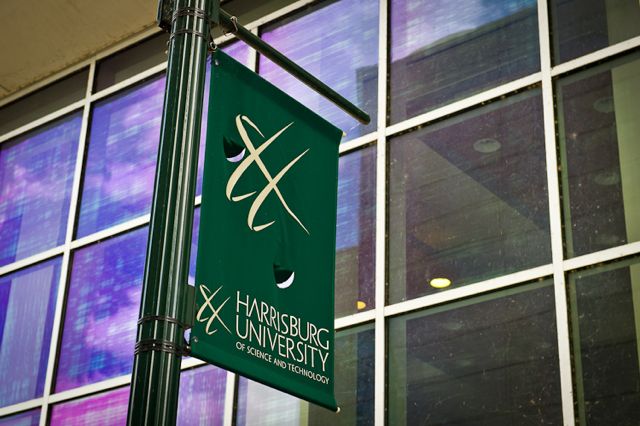 Harrisburg University Tax-exempt bonds not to exceed $100 Million.
Harrisburg University Tax-exempt bonds not to exceed $100 Million.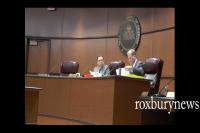 Dauphin County Commissioners Meeting February 13, 2019
Dauphin County Commissioners Meeting February 13, 2019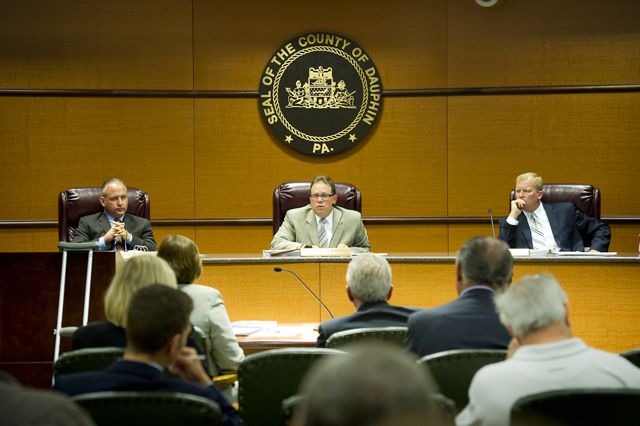 Dauphin County Commissioners Meeting February 13, 2019
Dauphin County Commissioners Meeting February 13, 2019 Modified Harrisburg Strong Plan Presented to Judge Bonnie Leadbetter for approval in Commonwealth Court on Thursday, September 19th, 2013.
Modified Harrisburg Strong Plan Presented to Judge Bonnie Leadbetter for approval in Commonwealth Court on Thursday, September 19th, 2013.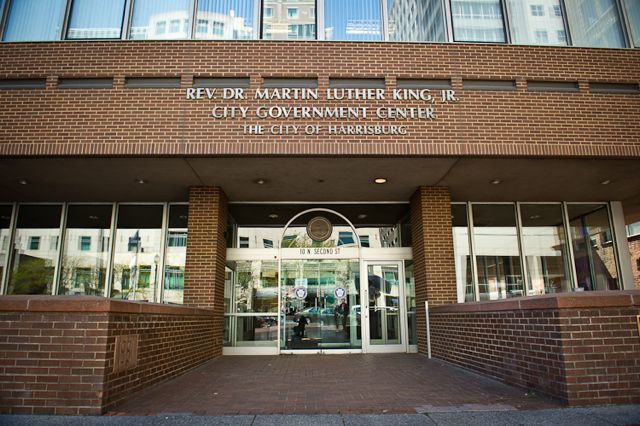 Harrisburg City Council - July 5, 2017
Harrisburg City Council - July 5, 2017
- State
- National
- Entertainment
-
Featured
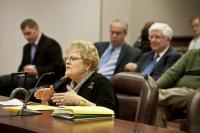 PA Senate Local Government Committee: Testimony of Carol Cocheres, Esquire
PA Senate Local Government Committee: Testimony of Carol Cocheres, Esquire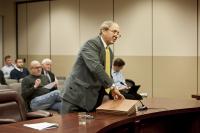 PA Senate Local Government Committee: Testimony of James Losty of RBC Capital Markets
PA Senate Local Government Committee: Testimony of James Losty of RBC Capital Markets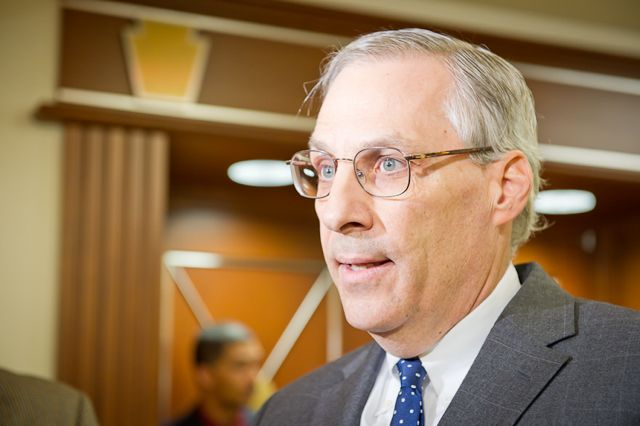 PA Senate Local Government Committee: Testimony of David Unkovic, former Receiver of the City of Harrisburg
PA Senate Local Government Committee: Testimony of David Unkovic, former Receiver of the City of Harrisburg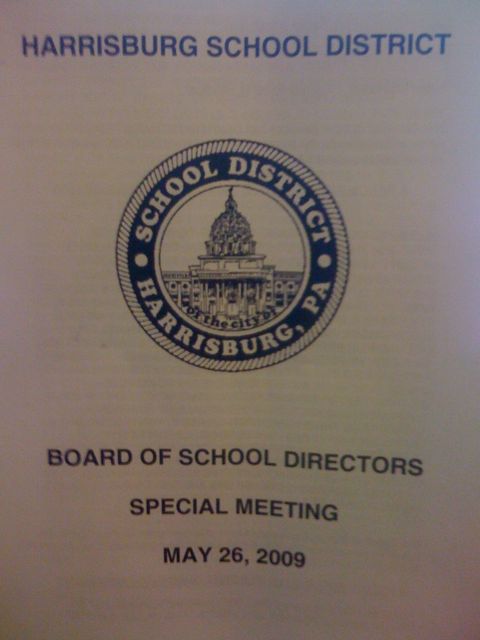 Bruce Barnes of Milt Lopus & Carol Cocheres of Eckert Seamans - A financing package of $280 million plus.
Bruce Barnes of Milt Lopus & Carol Cocheres of Eckert Seamans - A financing package of $280 million plus.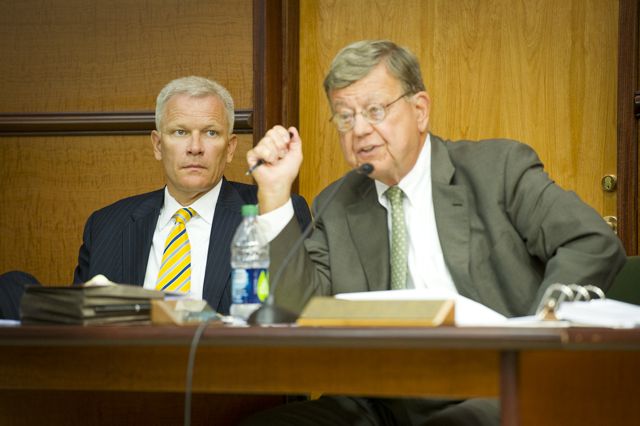 Special Report: Forensic Audit - Bruce Barnes presents. July 7, 2007. (Part 3)
Special Report: Forensic Audit - Bruce Barnes presents. July 7, 2007. (Part 3)
-
Election
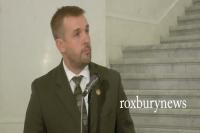 Pa State Rep. Bryan Cutler - December 1st 2022
Pa State Rep. Bryan Cutler - December 1st 2022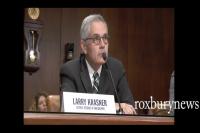 The Impeachment of DA Larry Krasner
The Impeachment of DA Larry Krasner The Special Master recommends that Fulton County be adjudged in civil contempt of the Injunction Order.
The Special Master recommends that Fulton County be adjudged in civil contempt of the Injunction Order.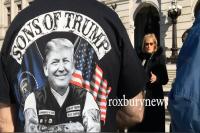 Archive Video - Abby Abildness Jericho March Harrisburg November 14th 2020
Archive Video - Abby Abildness Jericho March Harrisburg November 14th 2020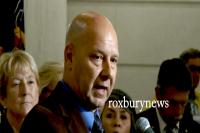 Archive Video - Proclamation of Penn's Quotes July 1, 2022
Archive Video - Proclamation of Penn's Quotes July 1, 2022 Philadelphia DA Larry Krasner - Articles of Impeachment
Philadelphia DA Larry Krasner - Articles of Impeachment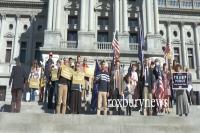 Jericho March November 8, 2020
Jericho March November 8, 2020 Doug Mastriano - Chambersburg Pa 9.16.22
Doug Mastriano - Chambersburg Pa 9.16.22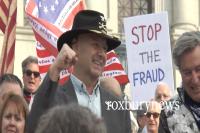 ReOpen Pa Rally - April 20, 2020
ReOpen Pa Rally - April 20, 2020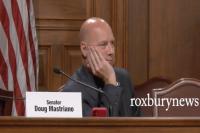 Doug Mastriano - Freedom Rally Capitol steps June 5th 2021
Doug Mastriano - Freedom Rally Capitol steps June 5th 2021
-
Join / Log In
-
Sign up by e-mail , with or
-
